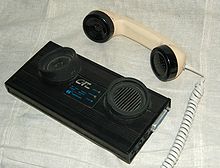Acoustic coupler
This article needs additional citations for verification. (October 2009) |



In
The link is achieved through converting electric signals from the phone line to sound and reconverting sound to electric signals needed for the end terminal, such as a teletypewriter, and back, rather than through direct
History and applications
The examples and perspective in this section deal primarily with the United States and do not represent a worldwide view of the subject. (September 2010) |
Prior to its
The situation was similar in other countries. In Australia, until 1975 the
It was not until a landmark U.S. court ruling regarding the
When inventors began developing devices to send non-voice signals over a telephone line, the need for a workaround for the Bell restrictions was apparent. As early as 1937,
The Weitbrecht Modem inspired other engineers to develop other modems to work with 8-bit ASCII terminals at a faster rate. Such modems or couplers were developed around 1966 by John van Geen at the Stanford Research Institute (now SRI International), that mimicked handset operations.[4] An early commercial model was built by Livermore Data Systems in 1968.[5] One would dial the computer system (which would have telephone company datasets) on one's phone, and when the connection was established, place the handset into the acoustic modem. Since the handsets were all supplied by the telephone company, most had the same shape, simplifying the physical interface. A microphone and a speaker inside the modem box would pick up and transmit the signaling tones, and circuitry would convert those audio frequency-shift keying encoded binary signals for an RS232 output socket. With luck one could get 300 baud (~bits/second) transmission rates, but 150 baud was more typical. That speed was sufficient for typewriter-based terminals, as the
The practical upper limit for acoustic-coupled modems was 1200 baud, first made available in 1973 by Vadic and 1977 by AT&T. 1200 baud endpoints became widespread in 1985 with the advent of the Hayes Smartmodem 1200A, though it used an RJ11 jack and was not an acoustic coupler. Such devices facilitated the creation of dial-up
Design
Usually, a standard telephone handset was placed into a cradle that had been engineered to fit closely (by the use of rubber seals) around the microphone and earpiece of the handset. A modem would modulate a loudspeaker in the cup attached to the handset's microphone, and sound from the loudspeaker in the telephone handset's earpiece would be picked up by a microphone in the cup attached to the earpiece. In this way signals could be passed in both directions.
Acoustic couplers were sensitive to external noise and depended on the widespread standardization of the dimensions of telephone handsets. Once they were made legal and the
Popular culture
An acoustic coupler (a Novation CAT 300 baud model) is prominently shown early in the 1983 film WarGames, when character David Lightman (portrayed by actor Matthew Broderick) places a telephone handset into the cradle of a film prop acoustic modem to accentuate the act of using telephone lines for interconnection to the developing computer networks of the period—in this case, a military command computer. The earliest major motion picture depicting an acoustic coupler was probably the 1968 Steve McQueen film Bullitt.
See also
Notes
- ^ "Phone Company Upheld in Ban on Hush-A-Phone," The New York Times, February 17, 1951, p. 29
- ^ Spot News, film, Chevrolet Motors Division of the General Motors Sales Corporation, 1937; this film is a 9:15 minute dramatic explanation of how newspapers transmitted photographs over telephone lines. The man sending the Fax places the telephone earpiece on the coupler at 3:14 before the explanation. The diagram shown at 6:30 clearly shows the earpiece on the coupler in the data path from fax scanner to receiver.
- OCLC 59576008
- ^ "Timeline of Computer History". Computer History Museum. Retrieved 2007-02-12.
- ^ "Acoustic Modem, with text [Gio] (1968)". Infolab Museum
- ^ "Wired 6.04 - Rj-11".
External links
- 1964 Livermore Data Systems Model A acoustic coupler modem surfs the web
- U.S. patent 3,553,374 Digitronics acoustic coupler patent, January 5, 1971
